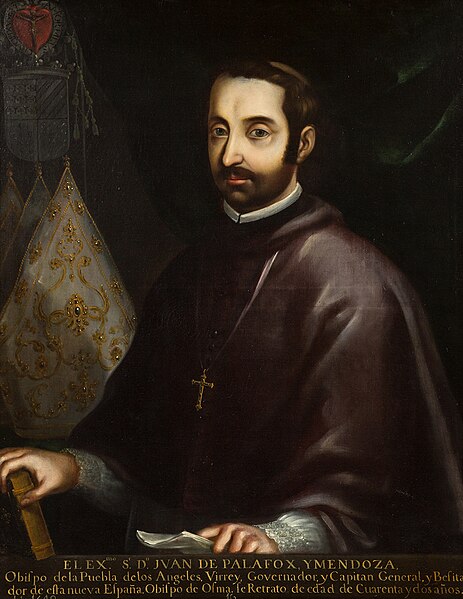Today a new Blessed was enrolled in the Church's official list - the Spanish bishop and defender of human rights, Juan de Palafox y Mendoza.
Blessed Juan was born in Navarre, Spain, on the 26th June 1600, the illegitimate son of Jaime de Palafox. His father was not too keen to accept the child as his own, so he was taken in and raised by a miller and his family who gave him the name, Juan. When he was ten his father finally accepted him as his son, and took responsibility for his education sending first to Alcala, and then to the University of Salamanca. He was a gifted young man, and so he became a deputy in the Cortes and later a prosecutor.
However, Juan's heart lay elsewhere, and so he decided to become a priest. When ordained he was appointed chaplain to the sister of the King of Spain, and as such accompanied her on various journeys around Europe.
Partially because of his ability, and perhaps mostly because of his connections, he was nominated as bishop of Puebla de los Angeles in the New World, now Mexico. He was formally appointed by the pope and consecrated bishop on the 27th December 1639. He arrived at his See the following June, not only as Ordinary, but also as visitator which the brief to investigate the administration of two previous viceroys of what was a Spanish colony. During his time in Mexico he also served as Archbishop of Mexico for a year while remaining bishop of Puebla, he also served as viceroy himself.
Once in the New World, Blessed Juan quickly saw how the native peoples were being treated, and he understood this as an offence to Christian teaching. At every opportunity he sought to protect the natives, forbade forced conversion and publicly opposed those who mistreated them. In other matters he was as diligent: he completed his diocese's cathedral and was a patron of the arts and education.
His strong defence of the natives and his ban on forced conversion led to issues which brought him into conflict with the Jesuits. Relations got so bad he was forced to impose an interdict against them in 1647. In retaliation the Jesuits excommunicated him twice, as if they had the power to do so, but also began to send formal complaints against him to Rome. Their campaign against him was successful, and the Pope, believing their accusations to be true, refused to confirm the interdict, though he did command the Jesuits to respect Blessed Juan's jurisdiction. The Jesuit final victory came in 1655 when, after Blessed Juan had signed an accord with them presuming this would lead to better relations with them, they used their influence to have him removed from his See and transferred back to Spain where he was appointed Bishop of Osma.
Despite these difficulties, Blessed Juan sought to follow God's will and overcome the trails he was forced to endure. He was a friend of a community of Discalced Carmelite sisters, and was highly influenced by St Teresa of Avila and St John of the Cross, so much so that his writings, of which there are many, are very much in the Carmelite tradition and the school of Spanish mysticism.
Worn out from his labours, but with a reputation for holiness both through his life and writings, Blessed Juan died on the 1st October 1659. The investigative process for his Cause was opened in his diocese, Osma, in 1666, and in Puebla de los Angeles in 1688. In 1694 the Cause found support in King Charles II of Spain when he petitioned Rome for the bishop's canonisation. The process was formally introduced in 1726, and, with the work completed, it seems he was proclaimed Venerable. A miracle had been identified - the cure of a Spanish priest from TB which was incurable then. The miracle was examined and approved, and so on the 28th February 1777 the way was cleared for this beatification. However, a new generation of Jesuits were as determined as a previous one to defeat Palafox, and they persuaded Pope Pius VI to suspend the Cause. Palafox, they thought, had finally been finished off for good.
However, they had not thought of a figure like Blessed John Paul II, who reopened the Cause in 2003, giving it to Palafox's spiritual family, the Discalced Carmelites, to process. In 2009 Pope Benedict approved his writings and declared him Venerable. The original miracle was reexamined, and approved (again), and today, at long last, 234 years after it should have happened, Juan de Palafox was beatified.
Phew! Revenge is a terrible thing, even the Saints fall prey to it. Blessed Juan's holiness was born of his sufferings. Like his spiritual parents, St Teresa of Avila and St John of the Cross, he recognised the purifying power of suffering, and its part in the journey which we know as the way of perfection.
Phew! Revenge is a terrible thing, even the Saints fall prey to it. Blessed Juan's holiness was born of his sufferings. Like his spiritual parents, St Teresa of Avila and St John of the Cross, he recognised the purifying power of suffering, and its part in the journey which we know as the way of perfection.
Congratulations to Fr Ildefonso, our postulator in Rome: he has done Trojan work on the Cause and has a fondness of Blessed Juan - I believe he keeps a picture of the bishop on his desk. Here is RomeReports video on the announcement of the decree of the miracle:
Here are the sacred remains of the new Blessed:



I presume the Jesuits will not be invited!
ReplyDelete